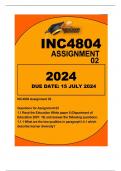,INC4804 Assignment 02
Questions for Assignment 02
1.1 Read the Education White paper 6 (Department of Education 2001: 16) and
answer the following questions:
1.1.1 What are the two qualities in paragraph1.4.1 which describe learner
diversity?
Two Qualities Describing Learner Diversity in Paragraph 1.4.1
Quality 1: Diverse Learning Needs
Paragraph 1.4.1 highlights that learners have diverse learning needs, which may
arise from various factors such as disabilities, socioeconomic background,
language, culture, and other contextual influences. This implies that each learner
has unique requirements that must be addressed to provide an equitable
educational experience.
Quality 2: Barriers to Learning
Another quality mentioned is the existence of barriers to learning that learners
might face. These barriers can be physical, systemic, or attitudinal, and they
impact the ability of learners to fully participate in educational activities.
Addressing these barriers is crucial to ensuring that all learners have the
opportunity to succeed.
REFERENCES
(Department of Education, 2001: 16).
1.1.2 Mention three examples of learner diversity cited in paragraph 1.4.1.
[3
, Disability: "The document emphasizes the need to accommodate learners with
disabilities, recognizing that these learners may require specialized support to
fully engage in educational activities"
Language and Cultural Background: "It also highlights the diversity in language
and cultural backgrounds, indicating the necessity for language support and
culturally responsive teaching methods" (Department of Education, 2001: 16).
Socioeconomic Status: "Socioeconomic factors are identified as another
dimension of diversity, with an emphasis on addressing the challenges faced by
learners from disadvantaged backgrounds" (Department of Education, 2001: 16).
Reference:
Department of Education (2001). Education White Paper 6. Pretoria: Government
Printer. (Paragraph 1.4.1)
1.2 Read the Education White Paper 6 (Department of Education 2001:7) and
draw up a simple table to illustrate the intrinsic (5) and extrinsic barriers (5) to
learning and development.
Intrinsic Barriers Extrinsic Barriers
1. Cognitive Barriers: Learning 1. Socio-Economic Barriers: Poverty,
disabilities, intellectual impairments. unemployment, lack of basic services
[Education White Paper 6, p. 7-8] and resources. [Education White Paper
6, p. 16-17]
2. Sensory Barriers: Visual, auditory 2. Attitudinal Barriers: Negative
impairments that hinder information attitudes towards learners with
processing. [Education White Paper 6, disabilities, cultural biases. [Education
p. 9] White Paper 6, p. 18]
3. Physical Barriers: Mobility 3. Inflexible Curriculum: Standardized
impairments, chronic illnesses assessments, lack of accommodation
affecting physical activity. [Education for diverse learning needs. [Education
White Paper 6, p. 9] White Paper 6, p. 19]
4. Emotional and Behavioral Barriers: 4. Lack of Teacher Training: Insufficient




